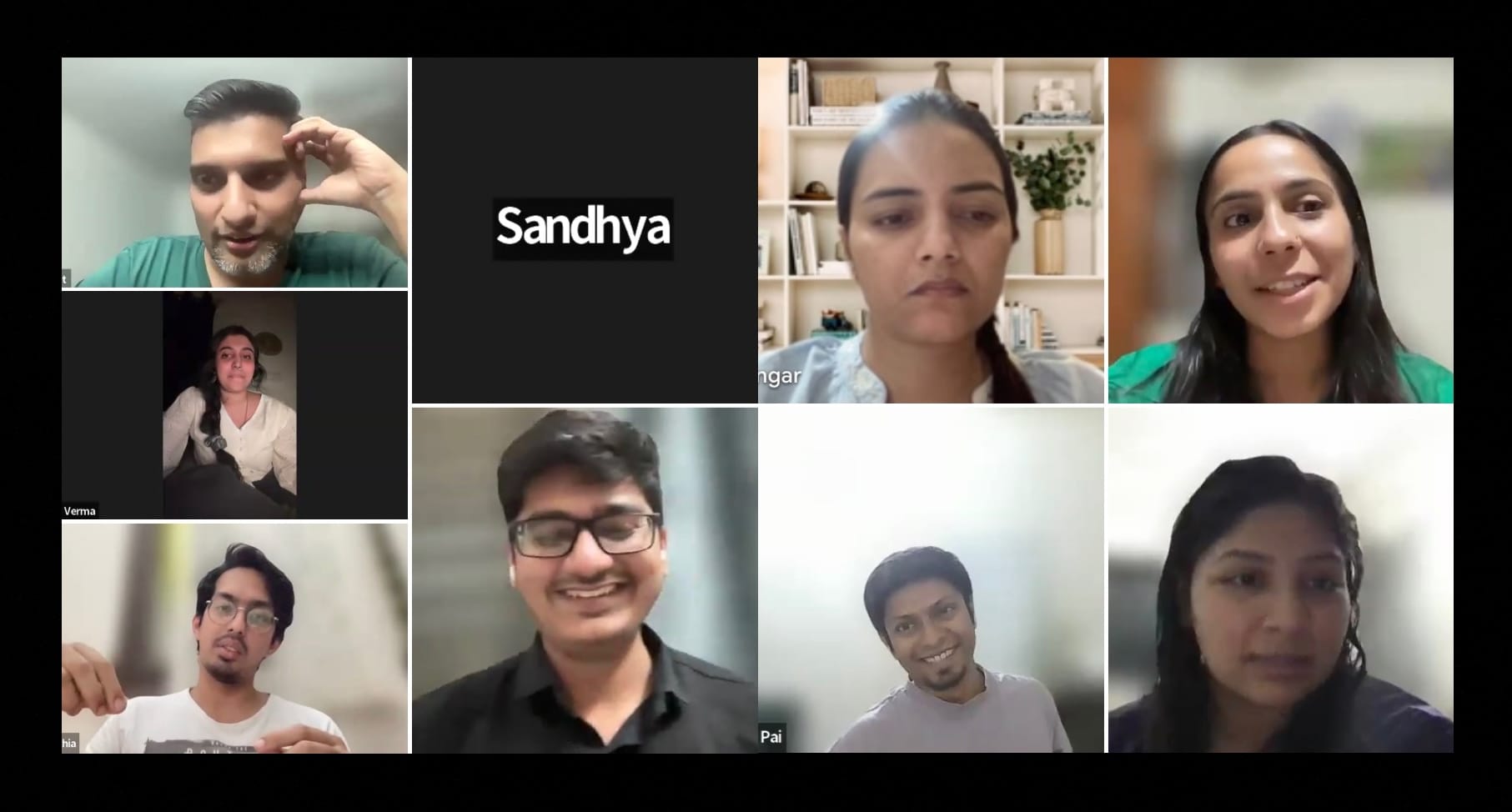EPC Dialogues 01: Reimagining the Intersection of Design, Sustainability, and Future Technologies

An exclusive deep dive into the first session of the Extended Pack Collective's Dialogues with the Designers of the collective.
The first EPC Dialogues, hosted by the Extended Pack Collective, wasn’t just a meeting; it was an exchange of bold ideas that lit up new ways of thinking about design with purpose. In a world shaped by climate change, rapid technology, and evolving values, this gathering brought together diverse voices to explore where big dreams meet real-world action.
The conversations ranged from how businesses can move beyond surface-level sustainability to futuristic ideas like storing digital data in living cells. While the topics were wide-ranging and ambitious, they stayed rooted in practical insight. This summary highlights what was shared and the deeper connections, challenges, and opportunities that emerged from the dialogue.
The Sustainability Paradox: Business Imperatives vs. Environmental Ethics
"The most sustainable thing is to not create anything new at all. But that's not how businesses survive." — Suraj.
The tension between profit and the planet was at the forefront of the discussion, with participants navigating the complex terrain between idealism and market realities. Suraj's scepticism about the financial viability of sustainable practices for emerging businesses wasn't mere cynicism—it reflected the genuine struggle entrepreneurs face when trying to balance environmental commitments with bottom-line necessities.
Mohit's addition, referring to a point in his podcast with Ankur Srivastava that "sustainability itself must be sustainable," cuts to the heart of a central design challenge: creating systems that can endure economically while supporting ecological well-being. This perspective has gained traction in institutional investment circles, where "resilient sustainability" recognises that environmental initiatives must maintain financial health to create lasting impact.
The Personal Approach: Micro-Actions and Cultural Shifts
Shyamli's perspective brought the conversation from boardrooms to living rooms, advocating for what anthropologists call "everyday sustainability"—the cumulative impact of individual choices. Her personal practice of limited consumption, strategic reuse, and mindful acquisition echoes not just Japanese mottainai but also Scandinavian lagom (the concept of "just enough") and the growing global movement toward "sufficiency" rather than endless growth.
The contrast between Scotland's cup discount system (mentioned by Grishma) and India's disposal culture illuminates how sustainability practices are culturally embedded. What works in Edinburgh might falter in Mumbai not just because of population differences but because of deeply ingrained consumption patterns, infrastructure limitations, and varying cultural relationships with material goods.
Yet, as India's plastic bag ban demonstrates, cultural tipping points can occur when policy, design, and social norms align. The ban initiated a cascade of innovations, from newspaper bags to banana-leaf packaging, showing how constraints can fuel creativity.
Beyond Green Marketing: Authentic Sustainability
The conversation revealed collective fatigue with what researchers call "green halo" marketing, where minimal environmental improvements are amplified through branding while core business models remain extractive. True sustainability in design requires structural reconsideration:
- Material Circularity: Designing with end-of-life in mind from the beginning
- Energy Consciousness: Accounting for production and usage energy footprints
- Waste Elimination: Moving beyond the concept of "waste" to see all materials as resources
- Cultural Longevity: Creating designs that resist trendy obsolescence
As indigenous designer Tyson Yunkaporta argues in "Sand Talk," sustainable design might learn more from 65,000 years of Aboriginal wisdom than contemporary marketing strategies.
Patagonia's "Don't Buy This Jacket" campaign stands as perhaps the most radical corporate sustainability statement, actively discouraging the consumption of its own products when unnecessary. Its Worn Wear program for repairs and investment of profits into environmental causes offer a blueprint for how businesses might reconcile commercial and ecological imperatives.
The group's discussion points toward a potential "post-sustainable" design paradigm in which we move beyond damage mitigation toward regenerative approaches that actively heal ecosystems through human activity, like buildings that purify air, textiles that sequester carbon, and systems that enhance biodiversity.
The Invisible Footprint: Digital Waste and Energy Consumption
"Each selfie stored forever is electricity running somewhere, forever."
— Dipti
Dipti and Sandhya's exploration of digital waste opened a window into one of the most overlooked environmental challenges of our time. While we've been educated about plastic in oceans and carbon in the atmosphere, the energy cost of our digital lives remains largely invisible—yet data centers already consume approximately 2% of global electricity, with consumption projected to reach 8% by 2030.
The Real Cost of the Cloud
The metaphor of the "cloud" itself contributes to this invisibility, suggesting something ephemeral, weightless, and natural. The reality is that massive server farms require constant cooling, backup systems, and enormous energy inputs. A single data centre can consume as much electricity as a small city.
Dipti's story about cleaning her photo gallery represents a nascent awareness of "digital footprints" in terms of privacy and environmental impact. Research from Lancaster University suggests that if every adult in the UK deleted just 10 emails, it would save energy equivalent to 1,500 flights from London to Madrid.
Circular Digital Design: A New Frontier
Sandhya's advocacy for circular digital thinking represents the cutting edge of sustainable design practice. This approach includes:
- Storage-conscious UX: Interfaces that encourage archiving or deletion
- Efficient code: Programs that accomplish more with fewer resources
- Format optimisation: Compression and file formats designed for energy efficiency
- Right-sizing data: Matching resolution and quality to actual usage needs
- Digital decluttering systems: Tools that identify redundant or unnecessary files
Companies like Google have pioneered machine learning algorithms that use 30% less energy in their data centres. Still, the consumer side remains unaddressed, and it is a potential innovation space for conscious designers.
The Efficiency Paradox
Mohit's point about digital interaction having a lower relative energy cost than physical alternatives introduces an important nuance, what economists call the "efficiency paradox." While digital books have a lower per-unit carbon footprint than physical books, the ease of acquiring digital content often leads to greater overall consumption, potentially negating efficiency gains.
This pattern appears across digital transformations: email eliminated paper but exponentially multiplied the volume of written communication. Understanding these rebound effects is crucial for designers seeking genuine sustainability.
AI and Energy: The New Frontier
The anecdote about Sam Altman and the computational cost of "please" points to an emerging concern as AI becomes ubiquitous. Training a single large language model can produce as much carbon as five cars over their lifetimes. As AI integrates into design tools and workflows, its energy implications become an ethical consideration for practitioners.
Some AI researchers are pioneering "green AI" approaches, models that maximise efficiency rather than capability. For designers, this might mean choosing energy-conscious tools and systems.
Practical Application:
Revisit your cloud storage strategy. Consider implementing a digital decluttering practice, a quarterly review of stored files, deletion of redundant data, and compression of rarely-accessed archives. For designers, this might include consolidating asset libraries and implementing file version limits.

Biology as Technology: Data Storage in Living Systems
"What if the cloud was actually... a cloud? Or at least made of leaves?"
— Rishav.
Rishav's introduction of the "Grow Your Own Cloud" project catapulted the discussion into speculative territory with solid scientific grounding. This concept represents what design theorist Tony Fry calls "Redirective practice"—using design to fundamentally rethink relationships between humans, technology, and natural systems.
The Science Behind Bio-Digital Storage
The statistics are staggering: DNA can store up to 215 petabytes of data per gram, making it approximately 100,000 times more efficient than conventional hard drives. This density exists because DNA packs information in three dimensions rather than on a two-dimensional surface.
What makes this approach revolutionary isn't just efficiency but longevity. While hard drives degrade within decades, DNA remains readable for thousands of years under the right conditions. Archaeological recovery of mammoth DNA from specimens over 10,000 years old demonstrates this durability.
The methodology works by translating binary code into DNA's four-letter alphabet (A, T, G, C), synthesizing those sequences, and storing them in living organisms. Retrieval involves sequencing the DNA and decoding it back to binary.
The Living Library: Mycelial Networks
Mohit and Sandhya mention mycorrhizal networks and the underground fungal connections between trees. Forest ecologist Suzanne Simard has extensively studied these networks, which don't just allow trees to share resources; they transmit information about threats, coordinate growth, and even appear to facilitate learning across plant communities.
These fungal networks are particularly relevant to bio-digital discussions because of their structural similarity to the Internet; both use decentralised protocols to share information across distributed nodes. Some researchers have suggested that understanding mycelial communication could inform new computing architectures.
Future Directions:
Integrating synthetic biology and information technology opens questions about "living interfaces". What if apps grew rather than launched? What if digital assistants were cultivated rather than programmed? Design theorist Koert van Mensvoort calls this "next nature"! A future where technology becomes so sophisticated it develops its own ecology.
Design Systems as Organisational Architecture
"A good design system doesn't just make things pretty, it makes teams efficient." — Grishma.
Grishma's builder-focused approach to design systems shifted the conversation from visual coherence to organisational velocity. Her emphasis on structured codebases enabling cross-functional momentum represents an evolution in how design systems are understood as UI libraries and collaborative infrastructures.
Beyond Components: Systems Thinking
The most sophisticated design systems today operate at multiple levels:
- Principles: The foundational values and approaches
- Patterns: Reusable solutions to common problems
- Components: The building blocks themselves
- Tokens: The fundamental variables (colours, spacing, etc.)
- Governance: The processes for evolution and decision-making
Grishma's focus on enabling backend developers and product managers to move independently highlights how design systems increasingly function as organisational operating systems rather than mere style guides.
The Flexibility Dilemma
The tension between standardisation and flexibility that emerged in the discussion echoes broader philosophical questions in systems design. Highly constrained systems offer consistency, performance, and predictability but may limit innovation. More flexible systems enable creativity but introduce complexity and maintenance challenges.
Different organisations resolve this tension according to their specific needs:
- Airbnb's approach prioritises a unified customer experience across all touch points
- Spotify's system enables team autonomy while maintaining brand coherence
- Google's Material Design balances platform-specific behaviour with cross-platform recognition
The group's discussion suggested a nuanced middle path: creating "constrained creativity" through well-defined parameters that still allow for meaningful variation.
Design Ops: The Missing Link
Implicit in Grishma's perspective is the growing importance of Design Operations, the organisational infrastructure that enables design at scale. This includes:
- Documentation strategies
- Contribution workflows
- Version control
- Testing protocols
- Training systems
- Adoption metrics
The most effective design systems are not only technically sound but also organisationally integrated, addressing human factors like learning curves, collaboration patterns, and governance structures.
Shopify's Polaris system stands out not just for its technical implementation but also for its organisational design. Each component team includes designers, developers, content strategists, and accessibility experts working in unified squads. This structure isn't accidental; it's an organisational manifestation of their design philosophy that components are multifaceted assets requiring diverse expertise.
The Future of Design Systems:
As AI increasingly enters the design process, design systems will likely evolve from static libraries to dynamic generators, systems that can produce context-aware solutions rather than fixed components. This shift from "component libraries" to "design algorithms" represents the next frontier in systematic design thinking.
Cultivating Collective Vision: Wolffkraft's Long-Term Approach
Mohit highlighted a crucial learning for designers and businesses. "Think Like a Brand, Act Like a Startup" by Rowan Gibson. The session concluded with Wolffkraft's strategic vision for the collective itself; a meta-design challenge of creating a community that balances aspiration with action and depth with momentum.
The Time Horizon Paradox
Mohit's encouragement to "think like brands with legacy" while "acting with startup speed" speaks to what organisational theorists call the "ambidextrous organisation," the one that can simultaneously explore new possibilities while efficiently executing known opportunities.
This approach has historical precedent in design institutions that have maintained cultural relevance across decades:
- Bauhaus balanced artistic exploration with industrial practicality
- IDEO combines deep design research with rapid prototyping
- Herman Miller maintains century-long material research while staying commercially viable
Self-Regulation and Quality
Perhaps most striking was Mohit's emphasis on the group's "self-regulating quality", a distinctly non-hierarchical approach to excellence. This evokes what scholar Etienne Wenger terms "communities of practice," where standards emerge through participation rather than imposition.
Unlike corporate quality systems and academic peer review, this approach suggests a third way. This is what design researcher Cameron Tonkinwise calls "critical making communities," where making and critiquing happen simultaneously through the same relationships.
Dialogue as Design Practice
The structure of the Dialogues itself reflects a design philosophy that values emergence over predetermined outcomes, diversity over conformity, and process over product. By creating space for conversation before action, the Extended Pack models what John Chris Jones called "designing designing"—the meta-activity of crafting how design happens.
From Talk to Transformation:
Historically, the most successful design collectives, from Memphis Group to Interaction Design Association, share a familiar pattern: they balance discourse with documentation and demonstration. Conversations generate ideas, but artefacts create impact. The Extended Pack's approach of dialogue followed by creation offers a promising model for transforming insight into influence.
The inaugural session has laid the groundwork for explorations that resist easy categorisation that exists at the edges where disciplines meet, where certainties dissolve, and where new possibilities emerge.
For designers navigating an era of cascading crises and breathtaking opportunities, such dialogue spaces aren't luxuries but necessities providing the collective intelligence needed to address challenges no single mind could solve alone.
The Extended Pack Collective welcomes design practitioners, theorists, and visionaries interested in joining the Collective. The onboarding to the collective happens only through our dinners or Signature events.One can request an invite on www.extendedpack.club/dinnerinvites
Do subscribe for the journal to peek into interesting conversations and though leadership by global designers and leaders.
Interesting reads and references to deep dive into the above discussed topics.
- McDonough, W. & Braungart, M. (2002). Cradle to Cradle: Remaking the Way We Make Things
- Thackara, J. (2015). How to Thrive in the Next Economy
- Newport, C. (2019). Digital Minimalism: Choosing a Focused Life in a Noisy World
- Grow Your Own Cloud Project: growyourown.cloud
- Simard, S. (2021). Finding the Mother Tree: Discovering the Wisdom of the Forest
- Fry, T. (2008). Design Futuring: Sustainability, Ethics and New Practice
